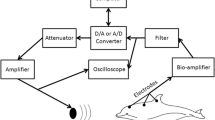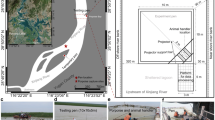Abstract
The hearing thresholds of the nurse shark, Ginglymostoma cirratum, and the yellow stingray, Urobatis jamaicensis, were measured using auditory evoked potentials (AEP). Stimuli were calibrated using a pressure-velocity probe so that the acoustic field could be completely characterized. The results show similar hearing thresholds for both species and similar hearing thresholds to previously measured audiograms for the lemon shark, Negaprion brevirostris, and the horn shark, Heterodontis francisi. All of these audiograms suggest poor hearing abilities, raising questions about field studies showing attraction of sharks to acoustic signals. By extrapolating the particle acceleration thresholds into estimates of their equivalent far-field sound pressure levels, it appears that these sharks cannot likely detect most of the sounds that have attracted sharks in the field.
Similar content being viewed by others
References
Banner A (1967) Evidence of sensitivity to acoustic displacements in the lemon shark, Negaprion brevirostris (Poey). In: Cahn PH (ed) Lateral line detectors. Indiana University Press, Bloomington, pp 265–273
Barber VC, Emerson CJ (1980) Scanning electron microscopic observations on the inner ear of the skate, Raja ocellata. Cell Tissue Res 205:199–215
Barber VC, Yake KI, Clark VF, Pungur J (1985) Quantitative analyses of sex and size differences in the macula neglecta and ramus neglectus in the inner ear of the skate, Raja ocellata. Cell Tissue Res 241:597–605
Barry MA (1987) Afferent and efferent connections of the primary octaval nuclei in the clearnose skate, Raja eglanteria. J Comp Neurol 266:457–477
Bass AH, Clark CW (2003) The physical acoustics of underwater sound communication. In: Simmons AM, Popper AN, Fay RR, (eds) Acoustic communication. Springer-Verlag, New York, pp 15–64
Bass AH, McKibben JR (2003) Neural mechanisms and behaviors for acoustic communication in teleost fish. Prog Neurobiol 69:1–26
Casper BM, Lobel PS, Yan HY (2003) The hearing sensitivity of the little skate, Raja erinacea: a comparison of two methods. Environ Biol Fishes 68:371–379
Corwin JT (1977) Morphology of the macula neglecta in sharks of the genus Carcharhinus. J Morphol 152:341–362
Corwin JT (1978) The relation of inner ear structure to the feeding behavior in sharks and rays. Scan Electron Micros II:1105–1112
Corwin JT (1981a) Audition in elasmobranchs. In: Tavolga WN, Popper AN, Fay RR (eds) Hearing and sound communication in fishes. Springer-Verlag, New York, pp 81–102
Corwin JT (1981b) Peripheral auditory physiology in the lemon shark: evidence of the parallel otolithic and non-otolithic sound detection. J Compar Physiol 142:379–390
Corwin JT (1989) Functional anatomy of the auditory system of sharks and rays. J Exp Zool – Suppl 2:62–74
Egner SA, Mann DA (2005) Auditory sensitivity of sergeant major damselfish Abudefduf saxatilis from post-settlement juvenitle to adult. Mar Ecol Prog Ser 285:213–222
Fay RR (1988) Hearing in vertebrates: a psychophysics databook. Hill-Fay Associates, Winnetka
Fay RR, Edds-Walton PL (1997) Directional response properties of saccular afferents of the toadfish, Opsanus tau. Hearing Res 111:1–21
Fay RR, Kendall JI, Popper AN, Tester AL (1974) Vibration detection by the macula neglecta of sharks. Comp Biochem Physiol 47A:1235–1240
Hueter RE, Mann DA, Maruska KP, Sisneros JA, Demski LS (2004) Sensory biology of elasmobranchs. In: Carrier JC, Musick JA, Heithaus MR, (eds) Biology of sharks and their relatives. CRC Press, Boca Raton, pp 325–368
Kalmijn AD (1988) Hydrodynamic and acoustic field detection. In: Atema J, Fay RR, Popper AN, Tavolga WN (eds) Sensory biology of aquatic animals. Springer-Verlag, New York, pp 83–130
Kelly JC, Nelson DR (1975) Hearing thresholds of the horn shark, Heterodontus francisci. J Acoust Soc Am 58:905–909
Kenyon TN, Ladich F, Yan HY (1998) A comparative study of hearing ability in fishes: the auditory brainstem response approach. J Compar Physiol A 182:307–318
Kritzler H, Wood L (1961) Provisional audiogram for the shark, Carcharhinus leucas. Science 133:1480–1482
Locascio JV, Mann DA (2005) Effects of hurricane charley on fish chorusing. Biol Lett 1:362–365
Lowenstein O, T.Roberts DM (1951) The localization and analysis of the responses to vibration from the isolated elasmobranch labyrinth. A contribution to the problem of the evolution of hearing in vertebrates. J Physiol 114:471–489
Lowenstein O, Osborne MP, Wersäll J (1964) Structure and innervation of the sensory epithelia in the thornback ray (Raja clavata). Proce Roy Soc London B 160:1–12
Mann DA, Higgs DM, Tavolga WN, Souza MJ, Popper AN (2001) Ultrasound detection by clupeiform fishes. J Acoust Soc Am 109:3048–3054
Myrberg AA Jr (1978) Underwater sound – its effect on the behaviour of sharks. In: Hodgson ES, Mathewson RF, (eds) Sensory biology of sharks, skates and rays. Government USPrinting Office, Washington, DC
Myrberg AA Jr (2001) The acoustical biology of elasmobranchs. Environ Biol Fishes 60:31–45
Myrberg AA Jr, Banner A, Richard JD (1969) Shark attraction using a video-acoustic system. Marine Biol 2:264–276
Myrberg AA Jr, Ha SJ, Walewski S, Banbury JC (1972) Effectiveness of acoustic signals in attracting epipelagic sharks to an underwater sound source. Bull Marine Sci 22:926–949
Nelson DR (1967) Hearing thresholds, frequency discrimination, and acoustic orientation in the lemon shark, Negaprion brevirostris (Poey). Bull Marine Sci 17:741–768
Nelson DR, Gruber SH (1963) Sharks: attraction by low-frequency sounds. Science 142:975–977
Nelson DR, Johnson RH, Waldrop LG (1969) Responses to Bahamian sharks and groupers to low-frequency, pulsed sounds. Bull South Calif Acad Sci 68:131–137
Olla B (1962) The perception of sound in small hammerhead sharks, Sphyrna lewini. Thesis MS, University of Hawaii
Popper AN, Fay RR (1977) Structure and function of the elasmobranch auditory system. Am Zool 17:443–452
Richard JD (1968) Fish attracted with low-frequency pulsed sound. J Fish Res Board Can 25:1441–1452
Rogers PH, Cox M (1988) Underwater sounds as a biological stimulus. In: Atema J, Fay RR, Popper AN, Tavolga WN, (eds) Sensory biology of aquatic animals. Springer-Verlag, New York, pp 131–149
Tester AL, Kendall JI, Milisen WB (1972) Morphology of the ear of the shark genus Carcharhinus, with particular reference to the macula neglecta. Pac Sci 26:264–274
Wisby WJ, Richard JD, Nelson DR, Gruber SH (1964) Sound perception in elasmobranchs. In: Tavolga WN (ed) Marine bio-acoustics. Pergamon Press, New York, pp 255–267
Acknowledgements
This research was conducted at the Florida Institute of Oceanographyȁ9s Keys Marine Lab (KML). We would like to thank Lonny Anderson and KML staff for assistance in collecting specimens and providing care for the animals. Thanks to James McConnell and Acoustech Corporation for the usage of the pressure/velocity probe. These experiments were covered under approved IACUC protocol #2118 from the University of South Florida and the Florida Institute of Oceanographyȁ9s Keys Marine Lab.
Author information
Authors and Affiliations
Corresponding author
Rights and permissions
About this article
Cite this article
Casper, B.M., Mann, D.A. Evoked Potential Audiograms of the Nurse Shark (Ginglymostoma cirratum) and the Yellow Stingray (Urobatis jamaicensis). Environ Biol Fish 76, 101–108 (2006). https://doi.org/10.1007/s10641-006-9012-9
Received:
Accepted:
Published:
Issue Date:
DOI: https://doi.org/10.1007/s10641-006-9012-9




